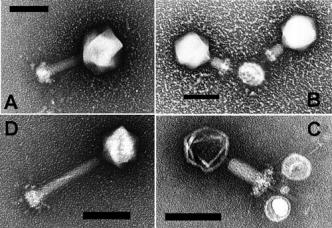Infecting climate change Understand article
Viruses help carbon sink deep down in the oceans.

cyanophage. Cyanophages
infect cyanobacteria that are
important players in the
ocean’s global carbon cycling.
Image courtesy of
Sullivan MB et al., PLoS Biology
Viruses are everywhere, and in large quantities. You may know that instinctively if you’ve had a cold recently, but it also applies in the oceans where scientists estimate that every milliliter of sea-water contains between 1 and 100 million viruses.
Viruses rely on other cells to multiply: they do not contain the necessary mechanism to replicate themselves, so they need to hijack the one of other living organisms. They prey on school pupils who don’t wear a scarf, but also on bacteria, plants, and all animals, with consequences that can go as far as death.
The quantity of viruses in the oceans creates the perfect conditions for a daily massacre. Every day, millions of bacterial, planktonic, algae, and animal cells die from viral infections. These dead cells are degraded into molecules that can either go back into the food chain and support the emergence of more biomass, or aggregate with other molecules and « sink » at the bottom of the ocean where it remains trapped.
The carbon that remains trapped in the ocean’s depths thanks to viruses is permanently removed from the atmosphere, thus helping to balance the growing emissions of carbonic gas. Viruses are one of the many ways that oceans can help mitigate the origins of climate change and prevent some of the excess of carbonic gas to remain in the atmosphere.
Resources
- For more details on marine viruses, you can read this fascinating article by Carl Zimmer.
- Check this detailed illustration of how the full carbon pump works in the ocean.





